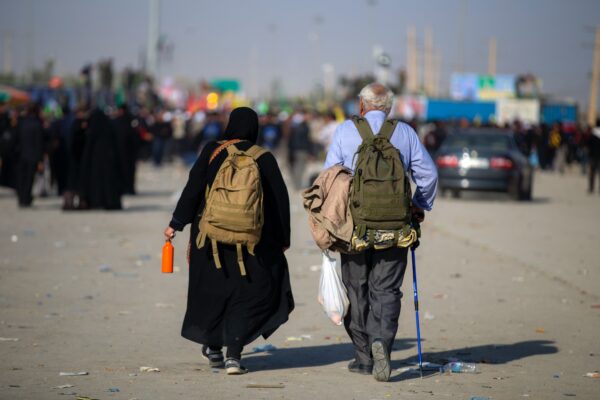Questions over the blatant lying of WMDs, the illegal invasion of the country, and the human rights abuses and war crimes that were committed in Iraq remain answered and unaccounted for.
Questions over the blatant lying of WMDs, the illegal invasion of the country, and the human rights abuses and war crimes that were committed in Iraq remain answered and unaccounted for.
It has been 20 years since the United States, along with its allies such as the UK, launched an illegal invasion of Iraq.
On March 20th, 2003, US President George W. Bush announced his promise to destroy the alleged weapons of mass destruction (WMD) in Iraq and end the rule of Saddam Hussein.
“At this hour”, President Bush stated at the time, “American and coalition forces are in the early stages of military operations to disarm Iraq, to free its people, and defend the world from grave danger.”
No weapons of mass destruction were ever found. And Iraq is continuing to recover from the horrifying effects of an invasion that left between half a million to more than one million Iraqis killed from the invasion – some reports claim that at least 2.4 million Iraqis were killed.
The US military infamously refused to keep a record of those killed in Iraq, with General Tommy Franks, who was in charge of the initial invasion, stating: “We don’t do body counts”.
Questions over the blatant lying of WMDs, the illegal invasion of the country, and the human rights abuses and war crimes that were committed in Iraq remain answered and unaccounted for.
What Happened
Many point towards the groundwork laid out years before to better understand the 2003 invasion, including when Iraq invaded Kuwait in 1990 and President George Bush Senior declared his goal to implement “liberal democracy” in Iraq. US neoconservatives, or neocons, grew in power during this time – pushing for Saddam Hussein to be deposed by any means possible.
And after 9/11, it suddenly became clear that it was necessary – that it was America’s moral duty – to invade Iraq and forcibly implement democracy.
Three weeks after their invasion, the US had seized the capital of Baghdad – famously toppling a statue of Saddam Hussein in Firdos Square. This powerfully symbolized US power in the region, and implemented a feeling of “victory” around the globe.
President George W. Bush was quick to respond, on May 1st declaring “mission accomplished” while on board the USS Abraham Lincoln aircraft carrier. But while declaring victory, however, Iraq was quickly descending into lawlessness – a direct result of the US invasion.
In May of 2003, Paul Bremer, the head of the Coalition Provisional Authority, had disbanded the Iraqi Army and banned the ruling Baathist Party from participating in government. This sudden decision left thousands alienated without a job or role within government – leaving an unstable power vacuum that would eventually be filled with the rise of Al-Qaeda, sectarian violence, and ISIS.
The End – Or The Beginning?
By the end of 2003, the US had captured Saddam Hussein – found hiding in a hole in the ground near Tikrit – and was later tried and executed in an Iraqi court for crimes against humanity.
It was only after the capture of Saddam that the US began to concede that its arguments for invading Iraq were unfounded – with a presidential commission in 2005 concluding that the US intelligence on WMDs in Iraq were fully flawed, with “not one bit” of evidence.
None of the leaders of the invasion, including US President George W. Bush or UK Prime Minister Tony Blair, were held accountable for a war that saw countless – literally countless – numbers of civilians killed, tortured, and traumatized for life.
In 2004 when the first photos were leaked from Abu Ghraib prison, there was a stunned shock in the United States – what had happened to bringing democracy and peace to the region? Although the US eventually tried 17 soldiers and officers for the unspeakable war crimes and human rights abuses that were committed in Abu Ghraib, little was done to correct the overarching issue at hand – the US invasion of Iraq was only the beginning of two decades of instability and human rights abuse to come.
What Now
Iraq remains precariously on edge. While many aspects of life have returned to normal, and many in the diaspora continue to travel back and forth between homes in Iraq and home abroad, it remains to be seen what exactly the future of Iraq holds.
US troops, Al-Qaeda, and ISIS have all left their mark on Iraq – and while any chain of events that happen throughout history are complicated and layered, it cannot be denied that the 2003 invasion of Iraq was such a catastrophic event that it led to an undeniable fall of what could have been one of the most powerful countries in the region.
Today, as we carefully watch Russia’s invasion of Ukraine, Israel’s continued illegal expansion into Palestine, and the US’ continued encroachment into countries across the world, we must be reminded and vigilant to stay wary of whose side of history we are on. What precedents do we see in history for invasion and illegal settlements? What examples from our own lifetimes can we remember to understand today’s world politics?
As Iraq marks 20 years since the US invasion, let us hope that the country may hopefully grow to be an example of what can happen despite all the odds, and hope that Iraqis themselves are the ones to see it happen.





